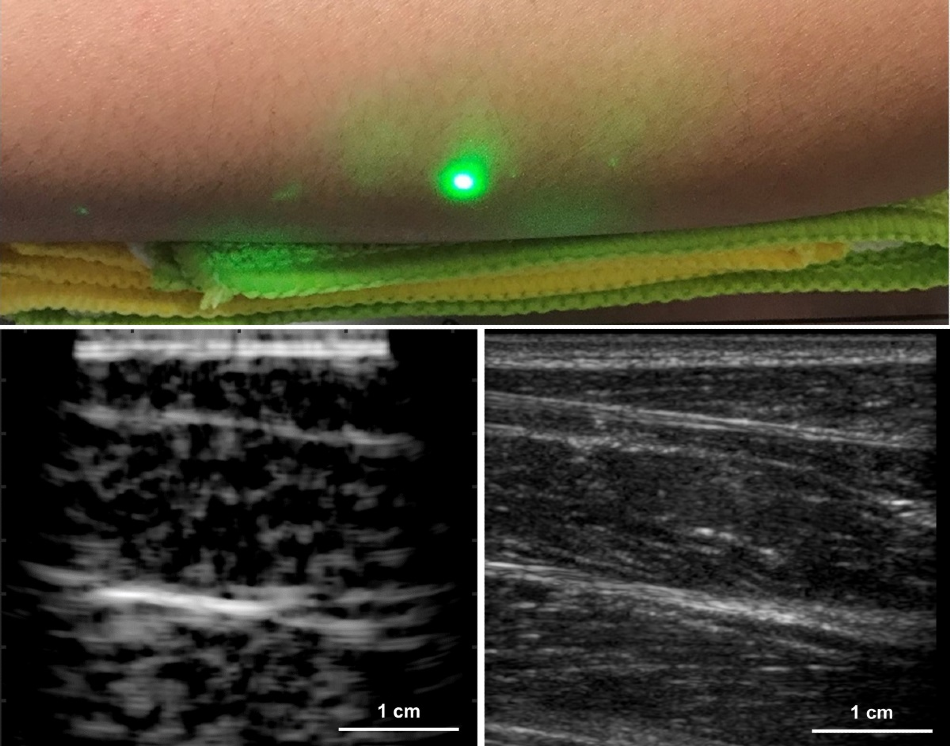 The new laser ultrasound technique was used to produce an image (left) of a human forearm (above), which was also imaged using conventional ultrasound (right). (Image Credit: Xiang Zhang, Jonathan Fincke, Charles Wynn, Matt Johnson, Robert Haupt, Brian Anthony)
The new laser ultrasound technique was used to produce an image (left) of a human forearm (above), which was also imaged using conventional ultrasound (right). (Image Credit: Xiang Zhang, Jonathan Fincke, Charles Wynn, Matt Johnson, Robert Haupt, Brian Anthony)
A team of researchers at Massachusetts Institute of Technology (MIT) in partnership with those at MIT Lincoln Laboratory, has established a new imaging technique that uses a non-contact ultrasound laser.
The method can be used in situations where physical contact is not possible, such as when doctors need to scan wounds. In addition, the method could potentially be used to help in the diagnosis of disease from a distance.
Developing an Ultrasound System that Doesn’t Require Contact
In a paper published last December in the journal Light: Science & Applications, the Massachusetts-based team, led by Xiang Zhang, describes how they generated sound waves using an infrared laser aimed at the surface of the skin. A second beam was used in conjunction with the infrared beam to pick up the propagating sound waves by measuring the vibrations of the skin given off as a response to the primary laser.
The development of the non-contact ultrasound laser addresses the limitations of the conventional ultrasound imaging technique. The conventional method requires transducers to be pressed up against the skin, usually with a gel to enable the transmittance of the acoustic waves into the tissue. While the technique is relatively cheap to conduct, easy to implement, and produces images in real-time, which has helped establish it as a widely used imaging technique, it does have its limitations.
Firstly, due to the fact that contact is required between the skin and the device, sensitive areas of skin cannot be tested with conventional ultrasound. This means that burn victims and trauma patients cannot be imaged with this method.
In addition, it is difficult to compare ultrasound images collected at different times. This is because the user manually defines the orientation and field-of-view, giving the method a low degree of reproducibility. As a result, conventional ultrasound cannot be used to reliably track and monitor disease progression or treatment effectiveness.
A New Method that Overcomes Conventional Ultrasound Limitations
While another method has been developed to overcome the issue of reproducibility, known as ultrasound tomography, no method has been developed that can tackle both reproducibility and skin contact issues.
The new system developed at MIT combines a new method of photoacoustic generation with an optical interferometer. The result is that the generation and measurement of sound waves can be achieved from a distance, without the requirement of physical contact. The technique generates acoustic energy by converting the maximum amount of light possible, meaning that it can penetrate further below the skin and generate images from deeper levels.
Pig tissue was used to test the technique before running human trials. The results of these tests showed that the technique was successful at imaging the same soft and hard-tissue features as conventional ultrasound, however, the images it produced were of lower quality. In addition, the new technique cannot currently produce images in real-time, as conventional ultrasound can. However, researchers remain confident about the future of their method. They point out that conventional ultrasound began with the limited capabilities of producing single images, progressing as technology advanced to imaging in real-time. Researchers believe the same path will be traveled by their new, non-contact technique.
While this is the goal for the more distant future, to develop non-contact ultrasound to have the capability of imaging in real-time, a more immediate goal is to see the system being used to help doctors image areas where direct contact with the skin surface is not possible. It is likely that it will be used to detect internal bleeding or fractures in painful areas in the near future. This kind of imaging does not need to be of high resolution, and so the technique could be used without the need for further development.
Disclaimer: The views expressed here are those of the author expressed in their private capacity and do not necessarily represent the views of AZoM.com Limited T/A AZoNetwork the owner and operator of this website. This disclaimer forms part of the Terms and conditions of use of this website.